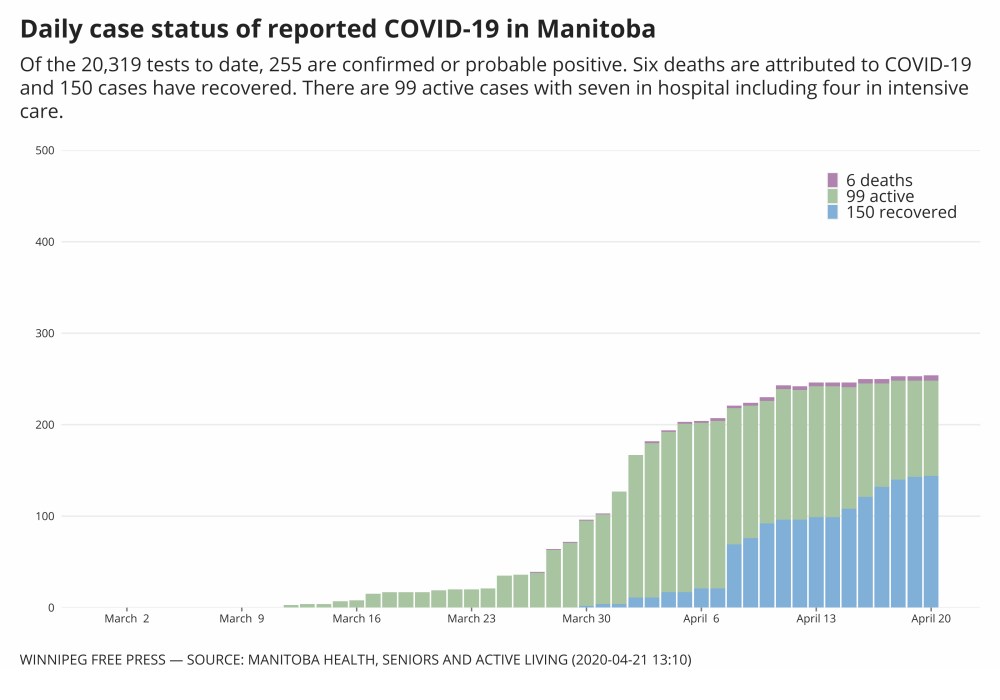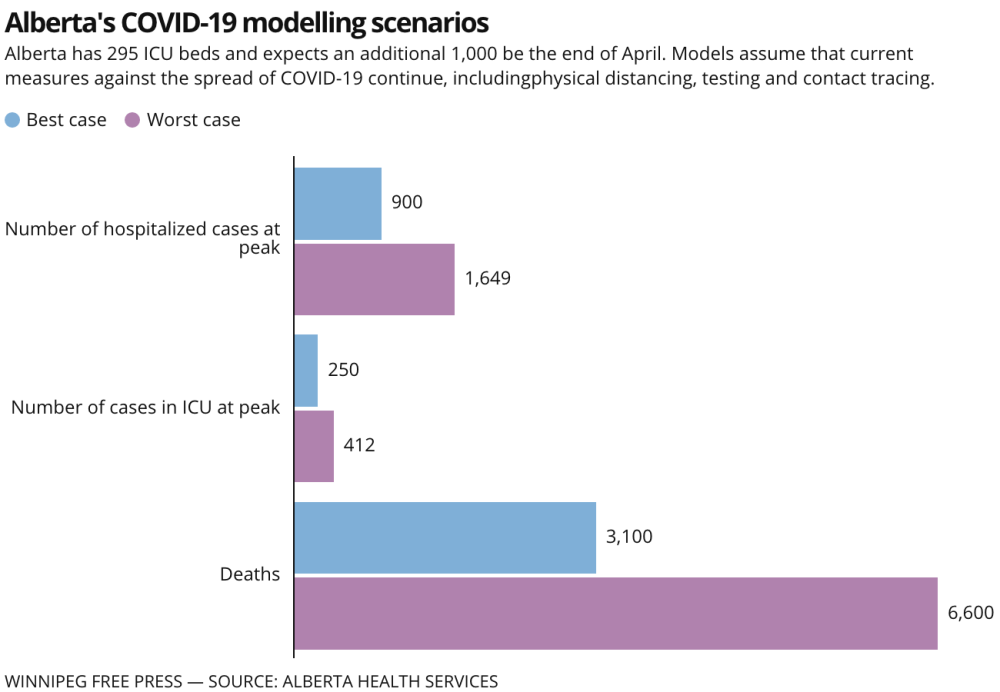Manitoba data not yet adequate to release virus projections, Roussin says
Read this article for free:
or
Already have an account? Log in here »
To continue reading, please subscribe:
Monthly Digital Subscription
$0 for the first 4 weeks*
- Enjoy unlimited reading on winnipegfreepress.com
- Read the E-Edition, our digital replica newspaper
- Access News Break, our award-winning app
- Play interactive puzzles
*No charge for 4 weeks then price increases to the regular rate of $19.00 plus GST every four weeks. Offer available to new and qualified returning subscribers only. Cancel any time.
Monthly Digital Subscription
$4.75/week*
- Enjoy unlimited reading on winnipegfreepress.com
- Read the E-Edition, our digital replica newspaper
- Access News Break, our award-winning app
- Play interactive puzzles
*Billed as $19 plus GST every four weeks. Cancel any time.
To continue reading, please subscribe:
Add Free Press access to your Brandon Sun subscription for only an additional
$1 for the first 4 weeks*
*Your next subscription payment will increase by $1.00 and you will be charged $16.99 plus GST for four weeks. After four weeks, your payment will increase to $23.99 plus GST every four weeks.
Read unlimited articles for free today:
or
Already have an account? Log in here »
Hey there, time traveller!
This article was published 21/04/2020 (2057 days ago), so information in it may no longer be current.
Even as Manitoba’s coronavirus infection rate continues to improve, the province is steadfast in refusing to release its long-term projections of the pandemic’s impact.
It’s a decision reiterated at Tuesday’s health briefing that’s in stark contrast to Ontario, which shared its latest projections Monday — a move of transparency it said was necessary for the public to fully understand the challenges facing the government.
“Providing this information is key to ensuring continued transparency with the public about the challenges that Ontario faces in dealing with COVID-19 and where there has been progress in flattening the curve,” the COVID-19: Modelling and Potential Scenarios report released Monday said. The 18-page report showed Ontarians that public-health interventions resulted in the virus peaking now rather than in May, and included such information as the total number of cases for the span of the outbreak is now likely to be less than 20,000, compared to the 80,000 projected earlier.

In Manitoba, that kind of modelling with potential scenarios has not been made public. For the last two weeks, government officials and chief provincial health officer Dr. Brent Roussin have indicated such projections would be made public in the coming days. Modelling and potential scenarios have been presented to the province but more data is needed before projections will be released to the public, said Roussin.
“We want to be able to provide actual modelling numbers with Manitoba data,” he said Tuesday when asked why a half-dozen provinces, including Saskatchewan with a similar pandemic experience to Manitoba, have made their projections public while Manitoba has not. The province’s top doctor has told reporters more than once that Manitoba is six weeks behind other jurisdictions in the pandemic, and more information is needed to prepare good projections.
“Just to do a calculation based on another jurisdiction and divide by our population doesn’t really tell you much,” Roussin said. “Those types of calculations don’t really predict what we’re going to see. Models are best made with Manitoba data and they’re best made when you have enough data and then they’re going to properly inform Manitobans,” he said.
Roussin reported one new Manitoba case Tuesday, for a total of 255, with 150 recovered. There are seven patients in hospital, including four in ICU.
He said mathematical and epidemiological modellers still don’t have enough data for good modelling and couldn’t say how much would be enough. “I don’t have a number that I could quote that would trigger a good model,” he said.
Premier Brian Pallister dismissed Ontario releasing its models and projections in the name of transparency. He pointed to an early model released by Ontario on April 6 that projected anywhere from 3,000 to 15,000 deaths in that province.

“One could argue that’s transparency. I would argue that’s conjecture,” said Pallister. His press conferences and the daily COVID-19 media briefings with Roussin and Shared Health nursing chief Lanette Siragusa are “transparency,” the premier said.
“Every pertinent question about the facts is being answered by me, by Dr. Roussin, by Ms. Siragusa and others,” he said. “The facts are what they are. The projections are a conjectured guess of where we might be in the future,” and “they’re all over the map, all over the world.” The premier said releasing Manitoba’s projections is up to Roussin, and he is not involved in what information the doctor shares.
“It would be false to state that this somehow was a lack of transparency, rather this is a willingness to be transparent and to be careful about being accurate about the numbers we give you.”
Canada’s former top doctor says each jurisdiction will have its own reasons for sharing information or not, and what is shared.
“There can be many reasons,” said Dr. David Butler-Jones who led the Public Health Agency of Canada for 10 years from 2004 to 2014 as it dealt with a number of outbreaks. The reliability of the model and assumptions can make it less useful, Butler-Jones said from Ottawa, adding he wasn’t aware of Manitoba’s position.

He said it sounds like the province’s modelling efforts weren’t as helpful as officials might have hoped.
“Other jurisdictions with smaller numbers have had similar challenges,” he said. Even with tons of good data, models are not a crystal ball for predicting the future.
“None of the modelling is predictive, but only lays out theoretical ‘what if’s’ to help guide planning on different options,” he said. “So far, all have pointed to the value of measures taken so far compared to what might have happened if the virus was left unchecked.”
As it stands, Manitoba has a low number of new cases — an average of less than two a day over the last nine days — and a low proportion of people testing positive. If the province can remain vigilant and prevent an outbreak from occurring, it’s in pretty good shape, Roussin indicated.
“We’re not seeing the propagation of the virus right now,” he said Tuesday.
The “R-value” — the reproductive rate of the virus — has gone from 2.5 or 2.6 to close to one, he said. The R-value is a virus’s basic reproductive number — an epidemiologic metric used to describe the contagiousness of infectious agents. It’s a theoretical number based on the average number of people who would be infected by a single case in a susceptible population. It needs to decrease to below one for social-distancing measures to be lifted, he said.

“Ideally, we’d look at one incubation period of 14 days and possibly up to 18 days of these numbers to tell us we’re in a stable environment.”
carol.sanders@freepress.mb.ca

Our newsroom depends on a growing audience of readers to power our journalism. If you are not a paid reader, please consider becoming a subscriber.
Our newsroom depends on its audience of readers to power our journalism. Thank you for your support.




